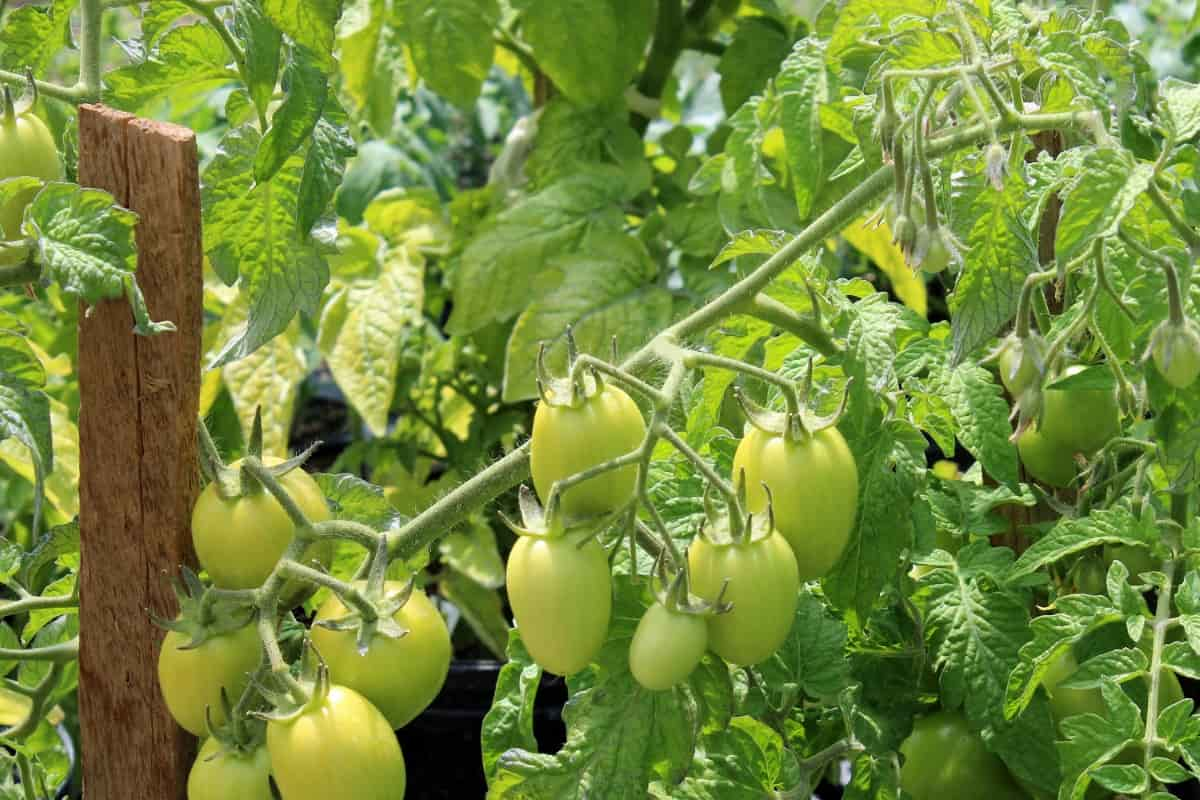Bone meal is a natural fertilizer derived from finely ground animal bones. It’s rich in essential nutrients that promote healthy plant growth, making it a good choice for Tomato plants. This organic amendment provides a slow-release source of phosphorus and calcium, two vital elements crucial for strong root development and overall plant vigor.

The Benefits of Bone Meal for Tomato Plants
There are many bone meal benefits for Tomato plant growth. One of the main benefits of using bone meal as a natural fertilizer for Tomatoes is that it slowly releases nutrients over time. This ensures that your Tomato plants receive a steady phosphorus supply throughout their growing season. Phosphorus is crucial in promoting root development for healthy and strong plants. This helps the plants establish themselves more effectively and efficiently absorb nutrients from the soil.
In addition to promoting root growth, bone meal also helps improve overall plant health. It provides a slow-release source of nutrients, ensuring that your Tomato plants receive a steady supply of essential elements throughout their growing season. Another benefit of bone meal is its ability to enhance fruiting in Tomato plants. The phosphorus content encourages flower formation and increases the number and size of fruits each plant produces.
Furthermore, the bone meal contains calcium, which helps prevent Tomato blossom end rot. Blossom end rot is a common problem characterized by dark spots on the bottom side of the fruit. Blossom end rot is a common problem in Tomato plants where the bottoms of the fruits become black and rotten, and calcium helps prevent this. Adding bone meal can help your Tomatoes develop evenly and remain healthy throughout their growth cycle.
Bone meal enhances fruit production by providing nutrients to support healthy flowering and fruiting processes. With the regular application of bone meal, you can expect an increase in the number of Tomatoes harvested. Bone meal also helps with fruit production. The high phosphorus levels in bone meal stimulate flowering and enhance fruit set. When incorporating bone meal into your gardening routine, you can expect bigger yields with plump and juicy Tomatoes.
Additionally, using bone meal as an organic fertilizer improves plant health and resilience against diseases and pests. The added minerals promote stronger stems and leaves while encouraging vigorous growth. Incorporating bone meal into your Tomato plant care routine can help ensure vigorous growth and bountiful harvests. However, always consider other factors such as soil quality, moisture levels, and sunlight exposure to provide optimal conditions for your Tomatoes.
When to Apply Bone Meal to Tomato Plants?
Generally speaking, you should only add bone meal once per season. The best time to do this is at the time of planting or transplanting. When to use a bone meal for Tomato plants? Adding bone meal at the beginning stages helps provide essential nutrients that promote root growth. This is crucial for setting a strong foundation for your Tomato plants. Incorporating bone meal into the soil during this early stage gives your Tomatoes an extra boost of phosphorus, which can help prevent common issues like blossom end rot.
In case you missed it: How to Make Bone Meal Fertilizer: Homemade Recipe, DIY for Container, Indoor, and Backyard Garden Plants

When applying bone meal to Tomato plants, it’s important to follow the recommended instructions provided by the manufacturer. Generally, you’ll want to sprinkle a small amount around each plant’s base before gently working it into the top layer of soil. Avoid directly contacting leaves or stems with bone meal, which may cause burn or damage.
How to Apply Bone Meal to Tomato Plants?
Applying bone meal to Tomato plants is a simple and effective way to give them the essential nutrients for healthy growth. Firstly, start by preparing the soil. Dig a hole or create a furrow in the soil where you will plant your Tomato. Next, sprinkle one large teaspoon of bone meal into the bottom of the hole. This will ensure that the roots of your Tomato plant come into direct contact with the bone meal, allowing them to absorb its nutrients more efficiently. After adding bone meal to the hole, mix it with some soil before placing your Tomato plant.
Gently cover its roots with soil, ensuring not to pack it too tightly around them. If you have already established Tomatoes, don’t worry. You can still apply bone meal around them by sprinkling one teaspoon on their soil layer. Afterward, gently incorporate a rake or garden fork into the soil. Remember that applying too much bone meal can lead to nutrient imbalances and may harm your plants rather than benefit them. Stick to using one large teaspoon per plant when planting or transplanting and avoid overusing it throughout their growing season.
Precautions and Considerations While Applying Bone Meal for Tomato Plants
Using bone meal as a fertilizer for Tomato plants can be beneficial, but it’s important to consider certain precautions and considerations. Be aware that bone meal is a slow-release fertilizer, which means it takes time for the nutrients to become available to the plants. Therefore, it’s best to apply bone meal well in advance of when your Tomatoes will need the nutrients. Another consideration is that bone meal contains a high amount of phosphorus.
In case you missed it: Bone Meal for Irises: Benefits, When, and How to Apply

While this nutrient is essential for plant growth and development, excessive amounts can lead to nutrient imbalances and harm your Tomato plants. It’s crucial to follow recommended dosage guidelines and avoid over-application. Additionally, if you have pets or wildlife in your garden area, remember that bone meal may attract them due to its organic material content. Consider using protective measures such as fencing or deterrents if necessary. Always wear gloves when handling bone meal to protect yourself from potential pathogens in raw animal bones.
How Much Bone Meal Per Tomato Plant?
To achieve the best results, it is recommended to use one large teaspoon of bone meal per Tomato plant during planting. This can be done by adding the bone meal directly into the planting hole and mixing it with the surrounding soil. By incorporating bone meal at this stage, you immediately give your young Tomato plants essential nutrients. Alternatively, if you have established Tomatoes in your garden, sprinkle one heaping teaspoon of bone meal around each plant. Then gently incorporate it into the soil using a rake or fork.
This method ensures that even established plants receive an extra boost of nutrients throughout their growing season. As for bone meal dosage and application methods for Tomatoes, adding it directly to the planting hole ensures that plants receive an immediate nutrient boost right from their early stages. Sprinkling bone meal around established plants helps replenish nutrients throughout their growing season.
Frequency of Bone Meal Application on Tomato Plants
Optimizing Tomato plant growth with bone meal application during the initial stages ensures that your plants receive a boost of essential nutrients right from the start. This will help establish strong roots and promote healthy growth throughout the growing season. However, as tempting as it may be to add bone meal throughout the season continuously, it’s important not to overdo it.
In case you missed it: Bone Meal for Hydrangeas: Benefits, When and How to Apply?

Too much phosphorus from excessive use of bone meal can lead to nutrient imbalances in the soil and hinder overall plant growth. Instead, provide a well-balanced fertilizer routine with other necessary nutrients for your Tomato plants. This can include organic compost, nitrogen-rich fertilizers, and potassium supplements.
Conclusion
Bone meal improves soil structure by enhancing its ability to retain moisture. This can be beneficial during hot summer when water retention becomes critical for plant survival. This organic fertilizer for Tomato plants is not only beneficial, but it’s also easy to use. By incorporating bone meal into your soil or applying it as a top dressing around established Tomato plants, you can ensure that your Tomatoes receive the necessary nutrients for plant growth and productivity.
- Feed Your Flock for Less: Top 10 Tips to Save on Chicken Feed
- Ultimate Guide to Ossabaw Island Hog: Breeding, Raising, Diet, and Care
- Hatching Answers: The Top 10 Reasons Your Chickens Aren’t Laying Eggs
- Eggs and Economics: Breaking Down the Cost of Raising Backyard Chickens
- Defend Your Greens: Proven Methods to Keep Iguanas Out of Your Garden
- Ultimate Guide to Cinnamon Queen Chicken: A Comprehensive Guide for Beginners
- Ultimate Guide to California Tan Chicken: Breeding, Raising, Diet, Egg-Production and Care
- Ultimate Guide to Marsh Daisy Chicken: Breeding, Raising, Diet, and Care
- 10 Types of Chicken Farming Businesses You Can Start for Profits